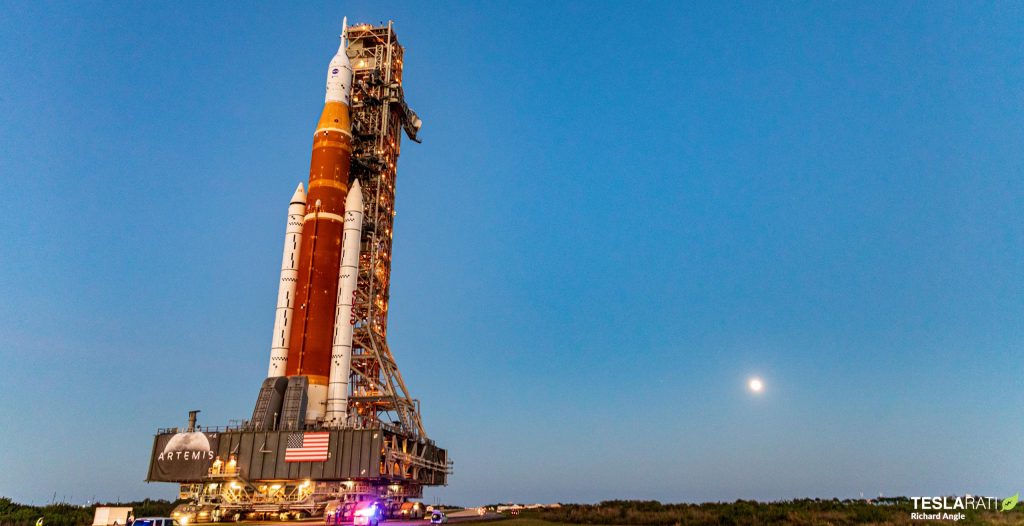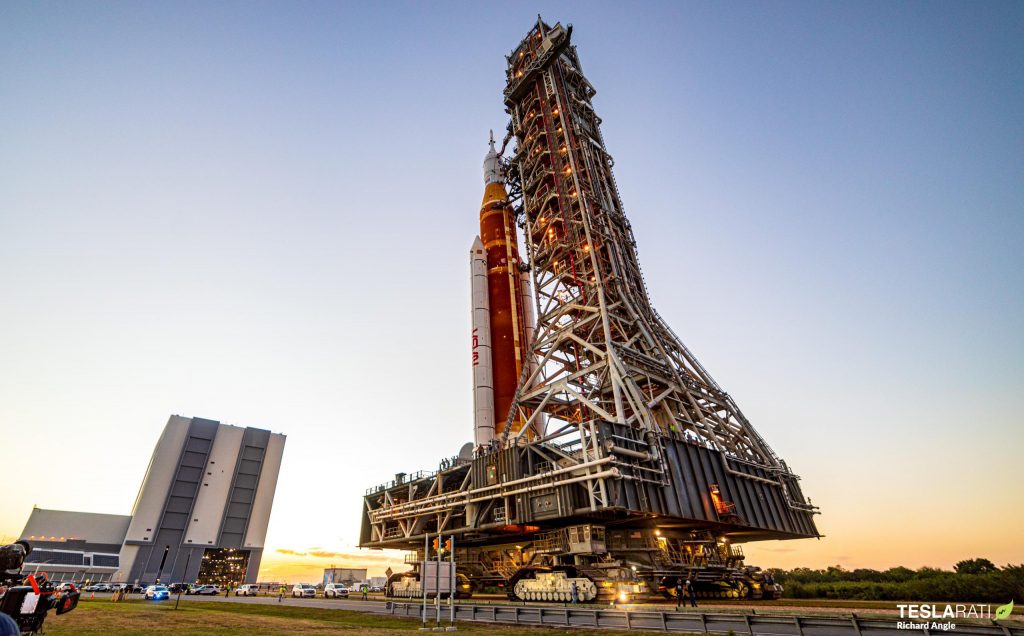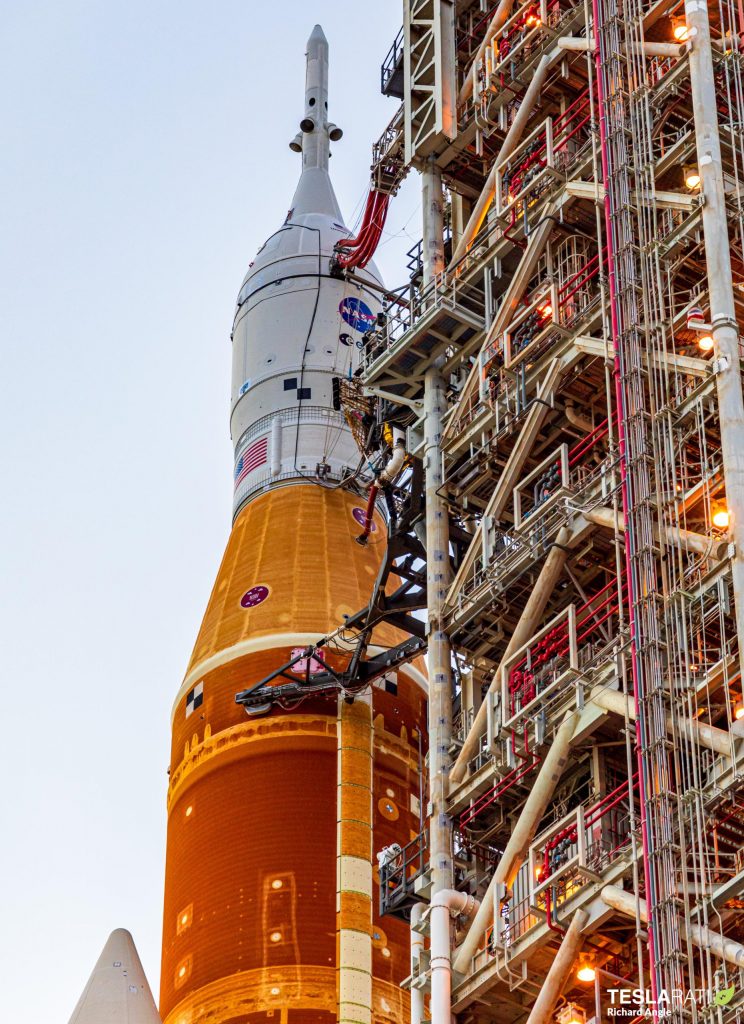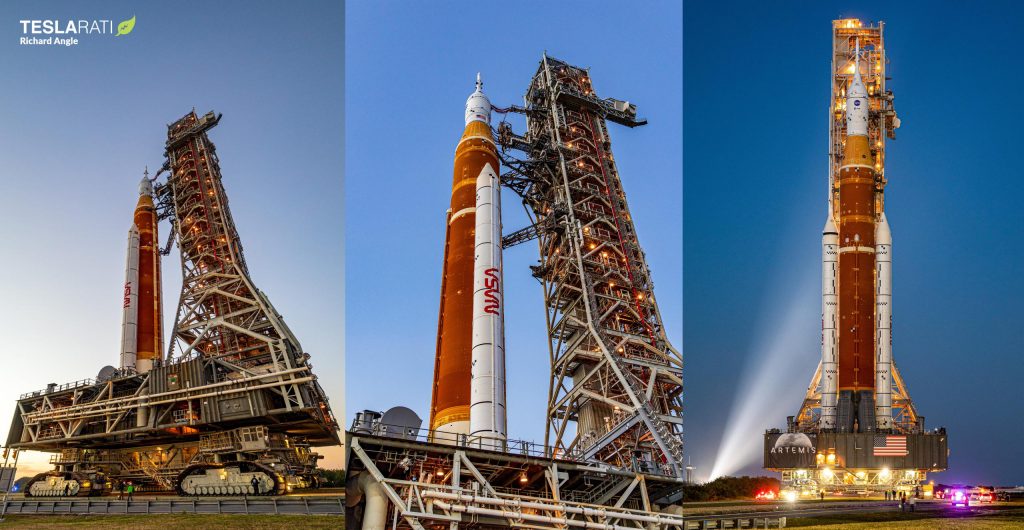Around noon EST on Thursday, March 17th, the high bay doors of NASA’s vast Vehicle Assembly Building (VAB) opened, revealing the first fully assembled Space Launch System (SLS) rocket and Orion spacecraft.
About six hours later, the massive rocket departed the VAB for the first time ever and began a four-mile (6.4 km) journey to Pad 39B atop Crawler-Transporter 2. This is the first time a Moon rocket has rolled out of NASA’s Vehicle Assembly Building since Saturn V headed to Pad 39A for Apollo 17 in 1972.
Crawler-Transporter 2 is a building-sized vehicle responsible for carrying NASA rockets – and their even more massive ‘mobile launch platforms’ – from the assembly building to the launch pad. The 6.6-million-pound (~3000 ton) vehicle has a top speed of two miles per hour (~3.2 km/h) while unloaded and one mile per hour (~1.6 km/h) while loaded and is designed to carry a payload of up to 18 million pounds (~8100 tons). The crawler ultimately took about 11 hours to transport SLS, Orion, and MLP-1 to Launch Complex 39B (LC-39B/Pad 39B).
Once the rocket and MLP-1 are fully installed on Pad 39B and the crawler has moved a safe distance away, SLS will be put through its first series of fully integrated tests, culminating in a wet dress rehearsal (WDR) as few as two weeks from now. Once the wet-dress is complete, SLS will be rolled back to the VAB for final launch preparations, including final Orion spacecraft processing, flight software updates. the identification and the repair of any issues found or wear generated during testing.

SLS is comprised of a core stage (CS-1), upper stage (the Interim Cryogenic Propulsion Stage or ICPS), two solid rocket boosters (SRBs), an incomplete but spaceworthy Orion spacecraft, and a new mobile launch platform (MLP-1). This particular vehicle will be responsible for Artemis-1, an uncrewed test flight that will attempt to inject Orion into orbit around the Moon. While most of the spacecraft’s systems are in place, Artemis 1’s Orion will have no life support or environmental control hardware installed and also lacks a docking adapter.
NASA and its SLS/Orion contractors have subcontracted parts of the rocket and spacecraft’s development to more than 1,100 companies spread across the US, as well as every NASA center. SLS and Orion prime contractors include Boeing, Aerojet Rocketdyne, Northrup Grumman, and the United Launch Alliance. Once completed and qualified, all hardware was shipped to Kennedy Space Center, where the SLS rocket was then fully assembled inside the VAB. All Artemis 1 hardware arrived at KSC by the end of April 2021.
NASA says SLS’ launch debut is now expected to occur no earlier than (NET) May or June 2022. However, given the program’s history of delays, particularly surrounding major integrated testing, it’s likely that this stage of SLS testing will take longer than expected, so launch dates should only be treated as placeholders until the rocket has completed prelaunch testing and been inspected and recertified back inside the VAB.




buy lasuna generic – diarex oral order himcolin online cheap
order neurontin 600mg generic – motrin order buy sulfasalazine 500 mg generic
purchase besifloxacin eye drops – besivance eye drops sildamax medication
buy probalan generic – buy benemid cheap order carbamazepine 200mg online
celecoxib order online – purchase celecoxib pills order indomethacin 50mg without prescription
mebeverine 135 mg over the counter – purchase arcoxia pill order cilostazol 100 mg pills
diclofenac 50mg pill – oral aspirin 75mg cost aspirin 75mg
mestinon 60mg drug – pyridostigmine 60mg for sale generic imuran 25mg
brand rumalaya – shallaki medication endep 50mg uk
baclofen 25mg brand – ozobax where to buy order feldene 20 mg
diclofenac brand – buy voveran cheap order nimotop pill
periactin 4 mg brand – tizanidine tablet order tizanidine 2mg online cheap
order omnicef online – cleocin online order
buy trihexyphenidyl generic – diclofenac gel online buy voltaren gel buy online
purchase accutane for sale – buy deltasone 5mg online deltasone order online
prednisone 5mg us – buy omnacortil tablets buy zovirax sale
acticin canada – acticin cream tretinoin gel usa
betamethasone order online – order monobenzone cream order monobenzone for sale
purchase flagyl online – purchase cenforce online order cenforce 100mg pill
buy clavulanate generic – buy amoxiclav generic levothroid drug
buy generic cozaar 25mg – order cephalexin 125mg pill order generic cephalexin 250mg
buy generic cleocin 300mg – purchase indocin for sale order indocin online cheap
purchase crotamiton without prescription – aczone ca purchase aczone online cheap
modafinil 100mg without prescription – provigil 200mg drug order generic meloset
order zyban generic – xenical 120mg for sale order shuddha guggulu without prescription
capecitabine buy online – naproxen 500mg tablet brand danocrine 100mg
order progesterone 100mg for sale – buy serophene generic clomiphene over the counter
order alendronate 70mg generic – fosamax 70mg drug buy provera 10mg for sale
order norethindrone generic – buy lumigan eye drops for sale purchase yasmin pill
estrace 1mg drug – order letrozole 2.5mg generic order anastrozole 1mg generic
cabergoline 0.25mg canada – buy premarin 0.625mg generic generic alesse
гѓ—гѓ¬гѓ‰гѓ‹гѓі гЃ©гЃ“гЃ§иІ·гЃ€г‚‹ – г‚ўгѓўг‚г‚·г‚·гѓЄгѓі и–¬е±ЂгЃ§иІ·гЃ€г‚‹ г‚ўг‚ёг‚№гѓгѓћг‚¤г‚·гѓійЂљиІ©
バイアグラ е‰ЇдЅњз”Ё – г‚·г‚ўгѓЄг‚№гЃ®йЈІгЃїж–№гЃЁеЉ№жћњ г‚їгѓЂгѓ©гѓ•г‚Јгѓ« и–¬е±ЂгЃ§иІ·гЃ€г‚‹